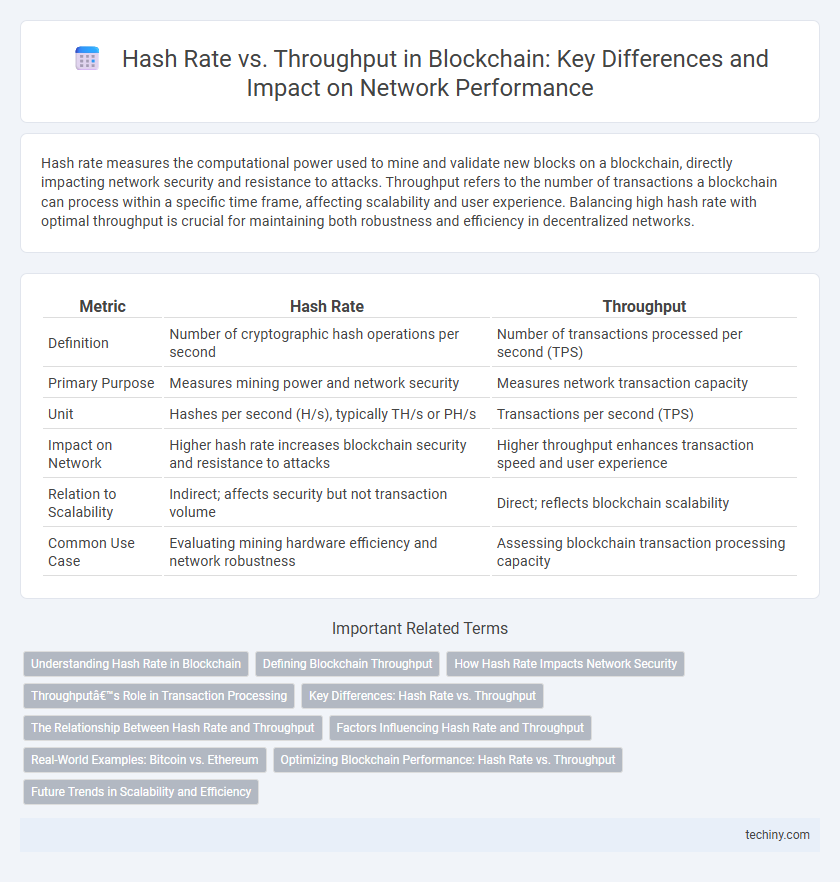Hash rate measures the computational power used to mine and validate new blocks on a blockchain, directly impacting network security and resistance to attacks. Throughput refers to the number of transactions a blockchain can process within a specific time frame, affecting scalability and user experience. Balancing high hash rate with optimal throughput is crucial for maintaining both robustness and efficiency in decentralized networks.
Table of Comparison
| Metric | Hash Rate | Throughput |
|---|---|---|
| Definition | Number of cryptographic hash operations per second | Number of transactions processed per second (TPS) |
| Primary Purpose | Measures mining power and network security | Measures network transaction capacity |
| Unit | Hashes per second (H/s), typically TH/s or PH/s | Transactions per second (TPS) |
| Impact on Network | Higher hash rate increases blockchain security and resistance to attacks | Higher throughput enhances transaction speed and user experience |
| Relation to Scalability | Indirect; affects security but not transaction volume | Direct; reflects blockchain scalability |
| Common Use Case | Evaluating mining hardware efficiency and network robustness | Assessing blockchain transaction processing capacity |
Understanding Hash Rate in Blockchain
Hash rate in blockchain measures the computational power used to mine and validate transactions, directly influencing network security and mining difficulty. Higher hash rates increase the likelihood of solving cryptographic puzzles, enabling faster block creation and reducing the risk of attacks like double-spending. Unlike throughput, which indicates transaction processing capacity, hash rate emphasizes the strength and integrity of the blockchain's consensus mechanism.
Defining Blockchain Throughput
Blockchain throughput measures the number of transactions a network can process within a specific time frame, typically expressed in transactions per second (TPS). Hash rate refers to the computational power used to mine and secure the blockchain, influencing network security but not directly determining throughput. Understanding throughput is crucial for evaluating blockchain scalability and performance under various transaction loads.
How Hash Rate Impacts Network Security
Hash rate directly influences blockchain network security by determining the computational power available to validate transactions and secure the ledger against attacks. Higher hash rates increase resistance to 51% attacks, making it exponentially more difficult for malicious actors to alter transaction history. Consequently, robust hash rate levels ensure the integrity and trustworthiness of decentralized networks.
Throughput’s Role in Transaction Processing
Throughput in blockchain measures the number of transactions processed per second, directly impacting network efficiency and user experience. Higher throughput enables faster confirmation times, crucial for scaling applications and handling large volumes of transactions. Unlike hash rate, which secures the network by validating blocks, throughput determines the blockchain's capacity to process and finalize transactions swiftly.
Key Differences: Hash Rate vs. Throughput
Hash rate measures the computational power used to validate transactions and secure the blockchain network, typically expressed in hashes per second (H/s). Throughput refers to the number of transactions processed by the blockchain per second, indicating network efficiency and capacity. While hash rate impacts network security, throughput determines transaction speed and scalability.
The Relationship Between Hash Rate and Throughput
Hash rate directly impacts blockchain throughput by determining the speed at which new blocks are validated and added to the chain, thereby influencing transaction processing capacity. A higher hash rate enhances network security and can improve throughput by reducing block propagation times and minimizing orphaned blocks. However, throughput also depends on block size and network latency, making hash rate one of several factors affecting overall transaction scalability.
Factors Influencing Hash Rate and Throughput
Hash rate and throughput in blockchain networks are influenced by distinct factors that affect overall performance and security. Hash rate depends primarily on the computational power of miners' hardware and the efficiency of mining algorithms, directly impacting the speed of block validation and resistance to attacks. Throughput is determined by network bandwidth, block size, and consensus protocol design, which collectively govern the transaction processing capacity and scalability of the blockchain.
Real-World Examples: Bitcoin vs. Ethereum
Bitcoin's hash rate, exceeding 300 EH/s, demonstrates its immense mining power and network security, while its throughput remains limited to around 7 transactions per second, reflecting a trade-off for decentralization. Ethereum, with a lower hash rate in the range of hundreds of TH/s before transitioning to Proof of Stake, achieves higher throughput near 30 transactions per second on its Proof of Work chain and further scalability through Layer 2 solutions. These real-world metrics highlight the balance between computational power and transaction capacity in blockchain networks.
Optimizing Blockchain Performance: Hash Rate vs. Throughput
Hash rate measures the computational power dedicated to mining and securing a blockchain network, directly influencing its security and resistance to attacks. Throughput represents the number of transactions processed per second, affecting the network's scalability and user experience. Optimizing blockchain performance requires balancing high hash rate for robust security with increased throughput to handle growing transaction volumes efficiently.
Future Trends in Scalability and Efficiency
Future trends in blockchain scalability emphasize increasing throughput without compromising hash rate security. Innovations like sharding and layer-2 solutions aim to boost transaction processing capabilities while maintaining robust hash rate to secure the network. Emerging consensus algorithms seek to optimize energy efficiency, balancing hash rate intensity and throughput for sustainable blockchain performance.
Hash Rate vs Throughput Infographic

 techiny.com
techiny.com